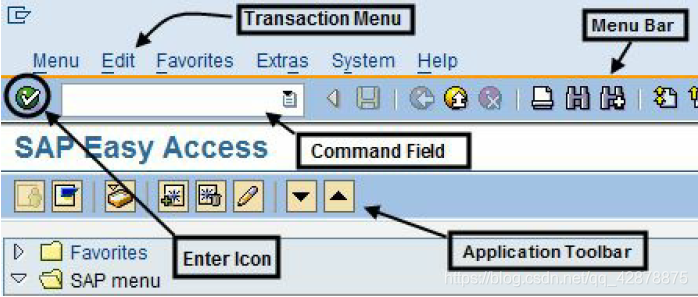Definition
Warehouse management is the process of coordinating the incoming goods, the subsequent
storage and tracking of the goods, and, finally, the distribution of the goods to their proper
destinations. In the past, warehouse management was very paper intensive in its
coordination of a multitude of activities. Since early 1990, this has changed with the
introduction of warehouse management system software.
So since 1990, warehouse management has drawn the attention of enough software companies to provide good solutions to manage the inventory, resources, and planning in the
warehouse. SAP is one such company that has worked hard to provide better solutions to manage and trace inventory, helping companies and warehouse managers to overcome their daily challenges.
Terminologies
Lack of understanding about warehouse terminologies will often make communication more complicated. Hence, it is important for the consultant to learn the warehouse terms. This
helps the consultant in everyday consulting jobs. Below are some of the terms, acronyms,
and abbreviations that are often used in the warehouse.
Putaway: Putaway is the process in which materials are put away after being received.
Material Handling: Material handling is the movement of the material to and from an
original location. This includes the travel of both material and the warehouse workers.
Picking: Picking is the process in which materials are picked from the source and taken to a given destination, usually for shipping or production.
Loading and Unloading: Loading is the action in which the materials are loaded on trucks, trailers, or rail cars, usually for shipping. During unloading, materials are removed from
trucks, trailers, or rail cars for storage in the warehouse or for consumption.
Cross-Docking: Cross-docking is the action of unloading materials from incoming trailers
and immediately loading those materials on outgoing or outbound trailers, thus eliminating
the need for warehousing.
Forklift Trucks: Vehicles used to lift, move, stack, and pick the materials in the warehouse.
Warehouse Operator: Person in the warehouse who unloads, does putaway, picks, or
loads the materials in the warehouse.
Aisles, Racks, Bins: Aisles are spaces for walking or drive forklift trucks between racks.
Racks are normally found either side of the aisles and contain several storage spaces or
slots, usually labeled for easy identification. Bins are spaces dedicated to storing materials.
Fixed Bin: This is a fixed space dedicated to one or more materials from where the
materials are issued to the production or shipping before picking from other bins.
Homogeneous Storage: All materials stored are the same kind.
Mixed Storage: Different materials are stored in the same bin. Addition to Stock: This is
usually performed to maximize the utilization of bin space by adding more stock to the bin.
Multipallet Bins: These are bins where more than one pallet can be stored, whether of the
same or a different kind.
Pallet: This is a flat transport structure used to store materials in a stable fashion while
being lifted by the forklift trucks.
ABC Indicators: These are used to identify the fast- and slow-moving materials.
Cycle Counting: Cycle counting is an inventory counting method that allows businesses to count materials in a number of areas within the warehouse without having to count the entire inventory.
Physical Inventory (PI): This refers to the process of counting all inventory in the warehouse.
Blind Count: This is a method of inventory where you provide the material numbers and location but no quantities.
Advanced Shipment Notification (ASN): ASN is used to notify a customer by a vendor of a shipment.
Direct or Drop Ship: Direct shipping and drop shipping are two terms generally used interchangeably. In this process, three parties interact with a sales transaction. The buyer orders a purchase from a seller, who then arranges with the supplier to ship the material directly to the buyers.
Introduction to SAP
SAP was founded in 1972 in Germany. The original SAP idea was to provide customers with the ability to interact with a common corporate database for a comprehensive range of applications. Gradually, the applications have been assembled, and today many corporations, including IBM and Microsoft, are using SAP products to run their own business.
SAP Jargon(术语/行话) and Abbreviations(缩略词)
SAP Abbreviations: It is common to use abbreviations in SAP. In this book we have used several of them. They are ERP for ECC/ERP systems, EWM for SCM Extended Warehouse Management, WM for ERP Warehouse Management, Org Structure for Organizational
Structure, IM for Inventory Management, MM for Materials Management, PI for Physical Inventory, FICO for Finance and Costing, QM for Quality Management, SD for Sales and Distribution, and PP for Production Planning.
CIF: In SAP, the term CIF refers to Core Interface. It is the interface that enables master
data to be exchanged between an ERP system and a EWM system.
QRFC: In SAP, the term qRFC refers to queued Remote Function Call. It is the interface
that enables transactional data to be exchanged between an ERP system and EWM system.
Introduction to SAP Menu
Sap menu is broadly divided into user menu and configuration menu.
User menu is used in day-to-day operations for reporting purposes and to create, change, and display the master and transactional data. The configuration menu is mainly used for configuring the system, both during implementation and in the maintenance phase.
In SAP, any transaction can be accessed in two ways: by navigating through the menu path or by entering T-Code in the command field.
Instead of navigating through the menu path, one can simply enter the T-Code in the command field, which will call the corresponding program and will display the transaction on the screen.
